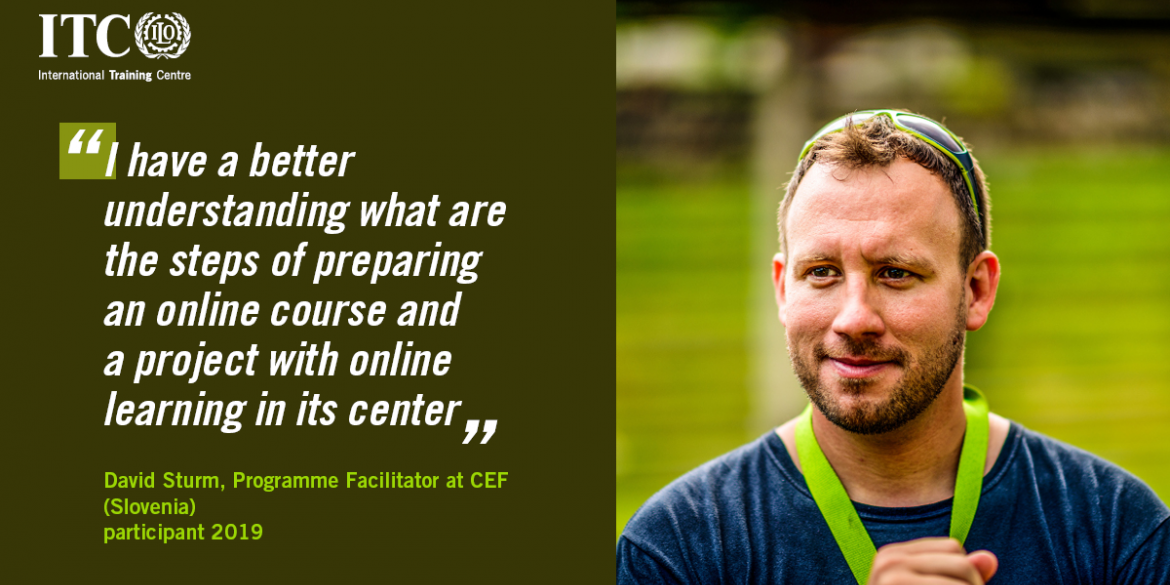Thoughtful Design is Key
Thoughtful Design is Key
Discussing effective e-learning delivery with David Sturm, Programme Facilitator at the Centre of Excellence in Finance, Slovenia.
28 janvier 2020

We had the pleasure of connecting with David Šturm, Program Facilitator at the Centre of Excellence in Finance, Slovenia after he attended the 2019 edition of the online course on e-learning design. His goal was to increase institutional capacity towards e-learning delivery.
Understanding the evolution of technology, making sense of how people learn
Part of our role as learning and development professionals is to make sense of the evolution of technology and ongoing shifts in the way people learn. We need to take a balanced approach that serves learners, supports the learning cycle, builds meaningful learning experiences, creates measurable impact, and serves learning teams.
Multimedia tools and technology certainly play a crucial role as learners need to digest content through infographics, mini-videos, graphs, links, PDF extracts, etc. However, the primary focus remains on how content is organized (sequential order, logical structure, facilitation of meaning, etc.).
Insights regarding e-learning design
After attending last year’s e-learning design course, David shared five takeaways and action points on how to improve e-learning delivery in his institution:
It is not the technology, but the design that makes the difference.
- Empathize with the target
Analysing the target audience is required to identify a variety of factors that will influence the design of any module or course. One key takeaway from this course is "The need to know your target audience in detail – I have decided to talk to people in the envisaged target audience to get a clearer picture." Empathy Map and User Persona techniques were explored in the course and provided hands-on templates to carry out interviews with a sample target to truly put yourself in their shoes.
- Guide e-learning design
"The importance of good and guided design of the e-learning course" is essential to come up with meaningful learning experiences. It’s necessary to translate the design of the course into micro-steps such as defining objectives, sequencing the content, and defining the right instructional strategy and evaluation strategy. "We will be using Design Thinking approaches" to make sure that e-learning delivery is learner-centred.
- Experiment with latest development tools
There are a number of different kinds of media elements that can be combined to create compelling e-learning modules. Nowadays it is possible to find, choose, and compare open source e-learning authoring tools to produce interactive content. "I found some great new tools and my favourite is H5P ," David shared.
- Support facilitation
Online facilitation and tutor-led courses are usually organized into sessions such as kick-off events, learning activities, assessments, feedback, and conclusion to make up for the physical presence. Even though facilitators are expert collaborators, it is necessary to provide guidance and embed it into the design of course facilitation. This is sometimes underestimated during the design of online courses as also shared by David: "I will have to research this part of e-learning to design our courses better and to support our facilitators."
- Create communities
"I started thinking what could be added to the project that I am preparing so people will 'have to' connect and work together," David explained. It’s vital to build communities of practice as part of the e-learning course design. Communities are not a stand-alone project.

Your turn
When it comes to effective e-learning delivery, thoughtful design is key.
There is no ready-made formula to deliver online education. It’s your team’s responsibility to brainstorm, make decisions upon learners’ styles, characteristics, and instructional purposes.
E-learning entails the creation of meaningful experiences. Only at the end does technology come into play.
Learn more about e-learning design. Check out the details from the e-Learning Design Lab: Coaching on methods, tools and latest trends.


